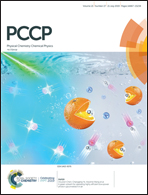Influence of framework Si/Al ratio and topology on electron transfers in zeolites†
Abstract
H-ZSM-5 and H-*BEA zeolites were hydrothermally synthesized with different Si/Al ratios (∼12 to ∼40). The physico-chemical properties of the resulting materials were fully characterized by several techniques (NMR, BET, PXRD, and pyridine thermal desorption followed by infrared spectroscopy). To assess the effect of the zeolite type and Si/Al ratio on sample reactivity, the charge separation processes between the zeolite framework and the adsorbed trans-stilbene (t-St) molecule were investigated by UV-visible diffuse reflectance and FT-Raman spectroscopy. The UV-visible absorption spectra obtained after t-St adsorption show a clear difference depending on the zeolite type. It appears that the radical cation resulting from t-St spontaneous ionization is more stabilized in the MFI-type framework than in the *BEA topology. However, the amount and stability of the electron–hole pair resulting from the radical cation evolution to a charge transfer complex are more important in the *BEA zeolite. On the basis of the experimental results and physico-chemical properties of the sample, we found that the radical cation and the electron–hole stabilities are strongly dependent on the amount of hexacoordinated aluminum (Al(VI)) and more precisely on their environment, i.e. the distance between Brønsted sites and strong Lewis sites or Brønsted Strong Lewis Pairs (BSLPs).



 Please wait while we load your content...
Please wait while we load your content...